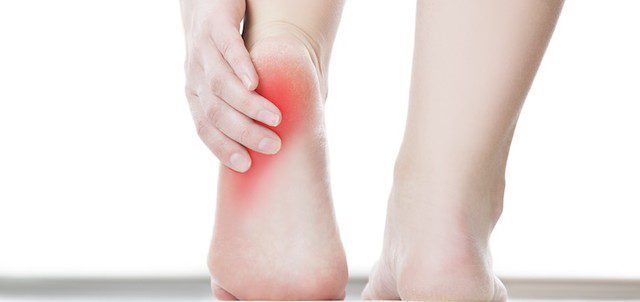What is Plantar Fasciitis?
Plantar fasciitis is a common and often debilitating foot condition, which is characterized by inflammation and pain in the plantar fascia; the thick band of tissue that runs along the bottom of the foot, connecting the heel bone to the toes. The plantar fascia plays a crucial role in supporting the arch of the foot and acts as a shock absorber during walking and running.

Common Symptoms of Plantar Fasciitis
The most common symptom of plantar fasciitis is pain in the heel or arch of the foot. The pain can often be quite intense, and is typically sharp and stabbing. Usually someone suffering with it notices that it tends to worsen with activity, especially after prolonged periods of rest. People suffering with this inflammatory condition often report intense foot pain with the first few steps in the morning after waking up.
Other symptoms may also include:
- Stiffness: Many people with plantar fasciitis experience stiffness and limited mobility in the affected foot, particularly after periods of inactivity.
- Tenderness: The heel or arch of the foot may be tender to the touch. Pressing on the affected area can elicit pain.
- Swelling: Inflammation can occur in the plantar fascia, leading to localized swelling in the heel or arch of the foot.
- Difficulty walking: The pain and stiffness associated with plantar fasciitis can make it challenging to walk or participate in activities that involve standing or prolonged periods of walking.
- Pain that improves with activity: While the pain may be worse after rest or in the morning, it often improves with gentle stretching and activity throughout the day. However, excessive activity or prolonged standing can exacerbate the pain.
What Causes Plantar Fasciitis?
Although the exact cause is not always clear, several factors can contribute to its development, which usually occurs when excessive and/or repetitive abnormal stress is placed on the plantar fascia, leading it to become irritated, inflamed, or even to develop small tears. There are several factors that can lead to the onset of plantar fascia, including:
- Overuse or repetitive strain: Activities that involve prolonged standing, walking, running, or jumping can put excessive stress on the plantar fascia, leading to inflammation and micro-tears in the tissue.
- Foot mechanics: Abnormal foot mechanics, such as flat feet (pronation) or high arches (supination), can affect the distribution of weight and increase strain on the plantar fascia.
- Tight calf muscles: Tightness or inflexibility in the calf muscles can put extra stress on the plantar fascia by altering the way the foot functions during walking or running.
- Improper footwear: Wearing shoes that lack proper arch support, have a poor cushioning, or do not fit well can contribute to the development of plantar fasciitis.
- Age and weight: Plantar fasciitis is more common in middle-aged individuals, and excess body weight can put additional strain on the plantar fascia.
- Certain activities and occupations: Athletes, especially runners and dancers, have a higher risk of developing plantar fasciitis due to the repetitive nature of their activities. Additionally, occupations that require prolonged standing or walking on hard surfaces can increase the likelihood of developing the condition.

How Cold Laser Therapy Can Help
It’s important to note that the symptoms of plantar fasciitis can vary in intensity and may come and go over time, but whatever the symptoms are, plantar fasciitis usually responds very well to Low-level Laser therapy treatments.
Low-level laser therapy (LLLT), also known as cold laser therapy, is a non-invasive treatment that uses low-intensity lasers and light-emitting diodes (LEDs) to stimulate tissue repair, reduce pain and inflammation and promote healing.
During LLLT treatment, the light and laser emitting source is applied to the affected area of the foot. The light penetrates the skin and stimulates the cells in the affected area to promote enhance cellular energy production, thereby promoting healing and reducing inflammation. This can lead to a reduction in pain and an improvement in mobility.

There is an abundance of research on LLLT and has shown it to be effective in reducing pain and inflammation associated with plantar fasciitis. LLLT is a safe and effective treatment option for plantar fasciitis, and it is often used in combination with other therapies such as stretching exercises, physical therapy, and custom orthotics.
Low-level laser has been studied extensively for various conditions like plantar fasciitis and study after study has shown just how and effective treatment option Cold Laser is.
Positive Research Findings:
Here are some positive research findings related to the use of LLLT for plantar fasciitis:
- Clinical Trials: Several randomized controlled trials (RCTs) have demonstrated the effectiveness of LLLT in treating plantar fasciitis. For example, a study published in the Journal of Foot and Ankle Surgery in 2018 found that LLLT significantly reduced pain and improved function in patients with chronic plantar fasciitis.
- Meta-Analysis: A meta-analysis published in the Journal of Foot and Ankle Research in 2019 reviewed 17 RCTs and concluded that LLLT provided significant pain reduction and improvement in functional outcomes for plantar fasciitis. The analysis also suggested that LLLT may be a valuable alternative to other treatment modalities.
- Mechanisms of Action: Research has investigated the mechanisms through which LLLT exerts its effects on plantar fasciitis. It is believed that LLLT enhances tissue repair and reduces inflammation by promoting cellular metabolism, improving blood flow, increasing collagen synthesis, and modulating pain perception.
- Long-Term Benefits: A study published in Lasers in Medical Science in 2017 followed up with patients who received LLLT for plantar fasciitis after one year. The results showed that the pain reduction and functional improvements achieved with LLLT were sustained in the long term, indicating its potential as a durable treatment option.
- Safety and Side Effects: LLLT is considered a safe and well-tolerated treatment modality for plantar fasciitis. It is non-invasive, non-thermal, and generally free from significant adverse effects. Studies have reported minimal or no side effects associated with LLLT treatment.
It is important to consult with a healthcare professional to determine if LLLT is the right treatment option for your specific case of plantar fasciitis.




